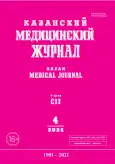Уровень маркёров апоптоза и пролиферации клеток в зоне рестеноза после реконструктивных вмешательств на артериях нижних конечностей
- Авторы: Калинин Р.Е.1, Сучков И.А.1, Климентова Э.А.2, Щулькин А.В.1, Герасимов А.А.2, Поваров В.О.1
-
Учреждения:
- Рязанский государственный медицинский университет
- Областная клиническая больница
- Выпуск: Том 102, № 4 (2021)
- Страницы: 453-458
- Тип: Теоретическая и клиническая медицина
- URL: https://journal-vniispk.ru/kazanmedj/article/view/61187
- DOI: https://doi.org/10.17816/KMJ2021-453
- ID: 61187
Цитировать
Аннотация
Цель. Оценка количества маркёров апоптоза и пролиферации клеток, а также их взаимосвязей в зоне рестеноза артериальных реконструкций.
Методы. В исследование включены 14 пациентов с диагнозом «Облитерирующий атеросклероз артерий нижних конечностей. Посттромботическая окклюзия бедренно-подколенных шунтов». Все пациенты были мужского пола с III стадией заболевания по классификации А.В. Покровского–Фонтейна. Средний возраст пациентов составил 65±3,4 года. Давность заболевания 9±2,5 мес после первоначального вмешательства. У пациентов во время выполнения повторных артериальных реконструкций забирали интраоперационный материал — дистальный анастомоз бедренно-подколенного шунта. В качестве контроля использовали образцы артериальной стенки, полученные во время эксплантации органов от посмертных доноров без облитерирующего атеросклероза артерий нижних конечностей. Количество образцов — 8. Участок их забора — подколенная артерия. После забора образцов их измельчали и готовили гомогенат с последующим определением белков р53, тромбоцитарного фактора роста ВВ, Bcl2 и Вах с помощью иммуноферментного метода. Статистический анализ проведён с использованием пакета программ Statistica 10.0. Групповые различия оценивали с помощью критерия Манна–Уитни. Коэффициенты корреляции определяли с помощью теста Спирмена. Данные представлены медианой и межквартильным интервалом.
Результаты. В образцах с рестенозом количество белка р53 составило 0,07 ед./мг и было значимо снижено в сравнении с контрольными образцами — 0,14 ед./мг (р=0,015). Количество тромбоцитарного фактора роста ВВ составило 0,17 нг/мг (р=0,05), Всl2 — 1,61 нг/мг (р=0,008), Вах — 6,0 нг/мг (р=0,25) в зоне рестеноза и было повышено в сравнении с их количеством в контрольных образцах (0,04; 0,9 и 4,4 нг/мг соответственно). Выявлена взаимосвязь между р53 и тромбоцитарным фактором роста ВВ (r=–0,724, р=0,002), тромбоцитарным фактором роста ВВ и Всl2 (r=0,672, р=0,003) в образцах с рестенозом зоны вмешательства.
Вывод. Сниженная активность апоптоза, выражающаяся в низких значениях белка р53 на фоне повышенного соотношения Всl2/Вах, связана с усилением пролиферативного ответа клеток сосудистой стенки в зоне рестеноза артериальной реконструкции.
Полный текст
Открыть статью на сайте журналаОб авторах
Роман Евгеньевич Калинин
Рязанский государственный медицинский университет
Email: klimentowa.emma@yandex.ru
Россия, г. Рязань, Россия
Игорь Александрович Сучков
Рязанский государственный медицинский университет
Email: klimentowa.emma@yandex.ru
Россия, г. Рязань, Россия
Эмма Анатольевна Климентова
Областная клиническая больница
Автор, ответственный за переписку.
Email: klimentowa.emma@yandex.ru
Россия, г. Рязань, Россия
Алексей Владимирович Щулькин
Рязанский государственный медицинский университет
Email: klimentowa.emma@yandex.ru
Россия, г. Рязань, Россия
Александр Андреевич Герасимов
Областная клиническая больница
Email: klimentowa.emma@yandex.ru
Россия, г. Рязань, Россия
Владислав Олегович Поваров
Рязанский государственный медицинский университет
Email: klimentowa.emma@yandex.ru
Россия, г. Рязань, Россия
Список литературы
- Zhu Z.R., He Q., Wu W.B., Chang G., Yao C., Zhao Y., Wang M., Wang S.M. MiR-140-3p is involved in in-stent restenosis by targeting C-Myb and BCL-2 in peripheral artery disease. J. Atheroscler. Thromb. 2018; 25 (11): 1168–1181. doi: 10.5551/jat.44024.
- Zhu H., Zhang Y. Life and death partners in post-PCI restenosis: Apoptosis, autophagy, and the cross-talk between them. Curr. Drug Targets. 2018; 19 (9): 1003–1008. doi: 10.2174/1389450117666160625072521.
- Калинин Р.Е., Сучков И.А., Климентова Э.А., Егоров А.А. К вопросу о роли апоптоза в развитии атеросклероза и рестеноза зоны реконструкции. Новости хир. 2020; 28 (4): 418–427. doi: 10.18484/2305-0047.2020.4.418.
- Климентова Э.А., Сучков И.А., Егоров А.А., Калинин Р.Е. Маркёры апоптоза и пролиферации клеток при воспалительно-фибропролиферативных заболеваниях сосудистой стенки (обзор). Соврем. технол. в мед. 2020; 12 (4): 119–128. doi: 10.17691/stm2020.12.4.13.
- Banfalvi G. Methods to detect apoptotic cell death. Apoptosis. 2017; 22 (2): 306–323. doi: 10.1007/s10495-016-1333-3.
- Gross A., Katz S.G. Non-apoptotic functions of ¬BCL-2 family proteins. Cell Death Differ. 2017; 24 (8): 1348–1358. doi: 10.1038/cdd.2017.22.
- Kolovou V., Tsipis A., Mihas C., Katsiki N., Vartela V., Koutelou M., Manolopoulou D., Leondiadis E., Iakovou I., Mavrogieni S., Kolovou G. Tumor protein p53 (TP53) gene and left main coronary artery disease. Angiology. 2018; 69 (8): 730–735. doi: 10.1177/0003319718760075.
- Cao R.Y., Eves R., Jia L., Funk C.D., Jia Z., Mak A.S. Effects of p53-knockout in vascular smooth muscle cells on atherosclerosis in mice. PLoS One. 2017; 12 (3): e0175061. doi: 10.1371/journal.pone.0175061.
- Kale J., Osterlund E.J., Andrews D.W. BCL-2 family proteins: changing partners in the dance towards death. Cell Death Differ. 2018; 25 (1): 65–80. doi: 10.1038/cdd.2017.186.
- Igase M., Okura T., Kitami Y., Hiwada K. Apoptosis and Bcl-xs in the intimal thickening of balloon-injured carotid arteries. Clin. Sci. (Lond.). 1999; 96 (6): 605–612. PMID: 10334966.
- Chen S., Dong S., Li Z., Guo X., Zhang N., Yu B., Sun Y. Atorvastatin calcium inhibits PDGF-ββ-induced proliferation and migration of VSMCs through the G0/G1 cell cycle arrest and suppression of activated PDGFRβ-PI3K-Akt signaling cascade. Cell Physiol. Biochem. 2017; 44 (1): 215–228. doi: 10.1159/000484648.
- Aravani D., Foote K., Figg N., Finigan A., Uryga A., Clarke M., Bennett M. Cytokine regulation of apoptosis-¬induced apoptosis and apoptosis-induced cell proliferation in vascular smooth muscle cells. Apoptosis. 2020; 25 (9–10): 648–662. doi: 10.1007/s10495-020-01622-4.
- Yonemitsu Y., Kaneda Y., Tanaka S., Nakashima Y., Komori K., Sugimachi K., Sueishi K. Transfer of wild-type p53 gene effectively inhibits vascular smooth muscle cell proliferation in vitro and in vivo. Circ. Res. 1998; 82 (2): 147–156. doi: 10.1161/01.res.82.2.147.
- George S.J., Angelini G.D., Capogrossi M.C., ¬Baker A.H. Wild-type p53 gene transfer inhibits neointima formation in human saphenous vein by modulation of smooth muscle cell migration and induction of apoptosis. Gene Ther. 2001; 8 (9): 668–676. doi: 10.1038/sj.gt.3301431.
- Bauriedel G., Hutter R., Schluckebier S., Welsch U., Prescott M.F., Kandolf R., Lüderitz B. Decreased apoptosis as a pathogenic factor in intimal hyperplasia of human arteriosclerosis lesions. Z. Kardiol. 1997; 86 (8): 572–580. doi: 10.1007/s003920050096.
- Scott S., O'Sullivan M., Hafizi S., Shapiro M., Bennett M.R. Human vascular smooth muscle cells from res¬tenosis or in-stent stenosis sites demonstrate enhanced responses to p53: implications for brachytherapy and drug treatment for restenosis. Circ. Res. 2002; 90 (4): 398–404. doi: 10.1161/hh0402.10590.
- Walsh K., Smith R.C., Kim H.S. Vascular cell apoptosis in remodeling, restenosis, and plaque rupture. Circ. Res. 2000; 87 (3): 184–188. doi: 10.1161/01.res.87.3.184.
Дополнительные файлы








